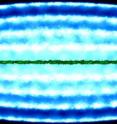Uncovering the forbidden side of molecules
Researchers at the University of Basel have succeeded in observing the "forbidden" infrared spectrum of a charged molecule for the first time. These extremely weak spectra offer perspectives for extremely precise measurements of molecular properties and may also contribute to the development of molecular clocks and quantum technology. The results were published in the scientific journal Nature Physics. Spectroscopy, the study of the interaction between matter and light, is probably the most important method for investigating the properties of molecules. Molecules can only absorb light at well-defined wavelengths which correspond to the difference between two quantum-mechanical energy states. This is referred to as a spectroscopic transition. An analysis of the wavelengths and the intensity of the transitions provides information about the chemical structure and molecular motions, such as vibration or rotation.
In certain cases, however, the transition between two energy levels is not permitted. The transition is then called "forbidden." Nevertheless, this restriction is not categorical, meaning that forbidden transitions can still be observed with an extremely sensitive method of measurement. Although the corresponding spectra are extremely weak, they can be measured to an exceptionally accurate degree. They provide information on molecular properties with a level of precision not possible within allowed spectra.
Precise measurements of molecular properties
Within the framework of the National Centre of Competence in Research QSIT -- Quantum Science and Technology, the research group headed by Professor Stefan Willitsch at the University of Basel's Department of Chemistry has established methods for the precise manipulation and control of molecules on the quantum level.
In the present study, individual charged nitrogen molecules (ions) were generated in a well-defined molecular energy state. The ions were then implanted into a structure of ultra-cold, laser-cooled calcium ions -- a Coulomb crystal -- in an ultra-high vacuum chamber. The molecular ions were thus cooled to a few thousandths of a degree above absolute zero to localize in space. In this isolated, cold environment, the molecules could be investigated without perturbations over long periods of time. This enabled the researchers to excite and observe forbidden transitions in the infrared spectral domain using an intensive laser.
Potential for new applications
The new method paves the way for new applications, such as the highly precise measurement of molecular properties, the development of extremely precise clocks based on individual molecules and quantum information processing using molecules. It also offers perspectives to test fundamental concepts using spectroscopic precision measurements on single molecules which were up to now the domain of high-energy physics. One example is the important question whether the physical constants of nature are actually really constant.
Source: Universität Basel
Other sources
- Uncovering the forbidden side of molecules: Infrared spectrum of charged molecule seen for first timefrom Science DailyMon, 22 Sep 2014, 10:01:27 UTC
- Uncovering the forbidden side of moleculesfrom PhysorgSun, 21 Sep 2014, 17:00:19 UTC
